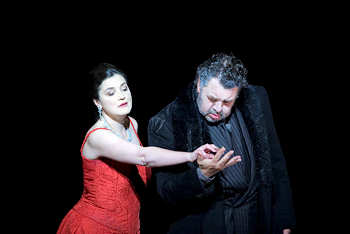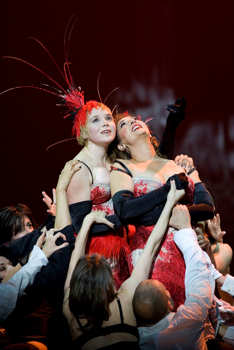Bartók and Weill at Welsh National
Opera:
(WNO premieres) Soloists and Orchestra
of Welsh National Opera / Carlo Rizzi
(conductor) Diversions Dance
Company, Wales Millennium Centre,
Cardiff, 23.5.2007 (BK)
Bartók: Duke Bluebeard's Castle
Bluebeard - Andrea Silvestrelli
Judith - Sara Fulgoni
Former wives: Samantha Hay, Dorothy
Hood, Sara Pope
Production:
Director: Willy Decker
Revival Director: Martin Gregor Lütje
Designer: John MacFarlane
Original Lighting Design: David Finn
Lighting Realisation for WNO: Robert
Marsh
Weill: The Seven Deadly Sins
Anna 1 - Marie McLaughlin
Tenor 1 - Mark Wilde
Tenor 2 - Andrew MacKenzie Wicks
Baritone - Owen Webb
Bass - David Soar
Dancers of the Diversions Dance
Company
Production:
Director: Roy Campbell-Moore
Designer: Jonathan Adams
Costume Designer: Paul Shriek
Lighting Designer: Malcolm Rippeth
Rehearsal Director: Joanne Fong

Sara
Fulgoni (Judith) and Andrea
Silvestrelli (Bluebeard)
Almost inevitably destined to be a
game of two halves, this pairing
of Bartók's operatic masterpiece
with the last collaborative effort
between Kurt Weill and Bertholt Brecht
seemed promising on paper.
Coupling
Bluebeard to a compact work of
equal artistic merit is never easy and
on the face of it, this was a bold,
innovative and wholly complementary
choice. Sadly it didn't work out that
way.
As
is so often the case these days, the
problem lay with production - or at
least in the contrast between the
two productions. Willy Decker's idea
of Bluebeard - first staged at
Royal Opera in 2002- is set in John
MacFarlane's damp, blood-stained and
derelict vision of the castle hall
which perfectly reflects the dread and
discomfort of the place to which
Bluebeard brings his new wife Judith. It is
deliberately oppressive, warmed -if
that's the right word - only
occasionally by the lighting
effects that accompany the opening of
the seven doors.
Inside this grim setting - perhaps a
representation of Bluebeard's own mind
- Willy Decker presents Judith as the
archetypal harpie, as malicious in her
own way as we generally imagine
Bluebeard to be. Though
Bluebeard pleads with her poignantly,
holding on to her pathetically as she
digs ever further into his secrets,
her demands become more and more
insistent until at last she discovers
the truth: the former wives are still
alive but like her have destroyed all
possibility of love with their
mistrust.
In
this production, text, action and
settings all work together to bring
out maximum meaning - including the
ambiguities - as carefully as
possible: and when the piece is
sung as well as it was here, the
cumulative effect is enthralling. Both
Sara Fulgoni and Andrea Silvestrelli
sing excellently, often with great
beauty of tone, and Carlo Rizzi's
thoughtful and atmospheric
accompaniment works seamlessly
with the singers to reveal the
composer's extraordinary achievement.
With the legendary
Ludwig/Berry/Kertesz recording always
in mind during this opera, this
performance measured up marvellously
and was a genuinely fine achievement
by WNO.

Marie
MacLaughlin (Anna I ) and
Diversions Dancers
If the
artistic gods had been kinder to me as
a child, a psychologist would have
spotted my rhythmic dyspraxia. This
life-long incapacity leaves me with
a complete ineptitude for dancing
myself, and with something much, much
worse... a total inability to make any
sense whatever of almost all
modern dance. Whenever I watch
it, the
Mock Turtle's school curriculum in
Alice in Wonderland keeps
spinning through my mind: 'We had
Reeling and Writhing,' the Mock Turtle
said sadly 'And also
.....Fainting in Coils.'
By
contrast with the coherence of the WNO
Bluebeard, this new production
of The Seven Deadly Sins comes
off rather badly. Roy
Campbell-Moore says in the programme
notes that after worrying about how to
introduce twelve dancers to Brecht's
narrative, the designer Jonathan Adams
suggested to him that seeing the piece
as a celebration of sin would give it
a 'more modern day feel' and would
allow a portrayal of
'decadent anarchy.'
The
upshot is that the five singers (the
four man 'Greek Chorus' and Anna 1) pop
out of a curved plastic surface
between the orchestra and the stage,
while the dancers (including Anna 2,
the dancing alter-ego of Anna 1)
reel and writhe non-stop to
illustrate the sinning.
But the
story is about the evils of capitalism
and how the Annas sell their souls to
raise money for grasping
relatives. It's hard to see this as
funny yet the audience laughed
out loud, especially at the portrayal
of Pride; a team of lady body-builders
posing for a competition.
Rhythmic dyslexia or not, I really
didn't get it.
The singing is uniformly fine.
Marie MacLaughlin sings Anna 1
as if born to it, the four man chorus
is excellent and Carlo Rizzi and his
orchestra make easy work of Kurt
Weill's engaging music. It's a
very decent production - apart
that is, from the dancing.
And if I
should ever get shot by hordes of militant
balletomanes, I'm arranging for my
headstone to read - like Spike
Milligan's -
'I told you I was ill.'
Bill Kenny
Note:
This performance of Bluebeard's
Castle was dedicated to the memory of
Terry Parr who died recently after
working for 36 years as WNO's
Head of Costume.
Pictures
© Bill Cooper 2007

